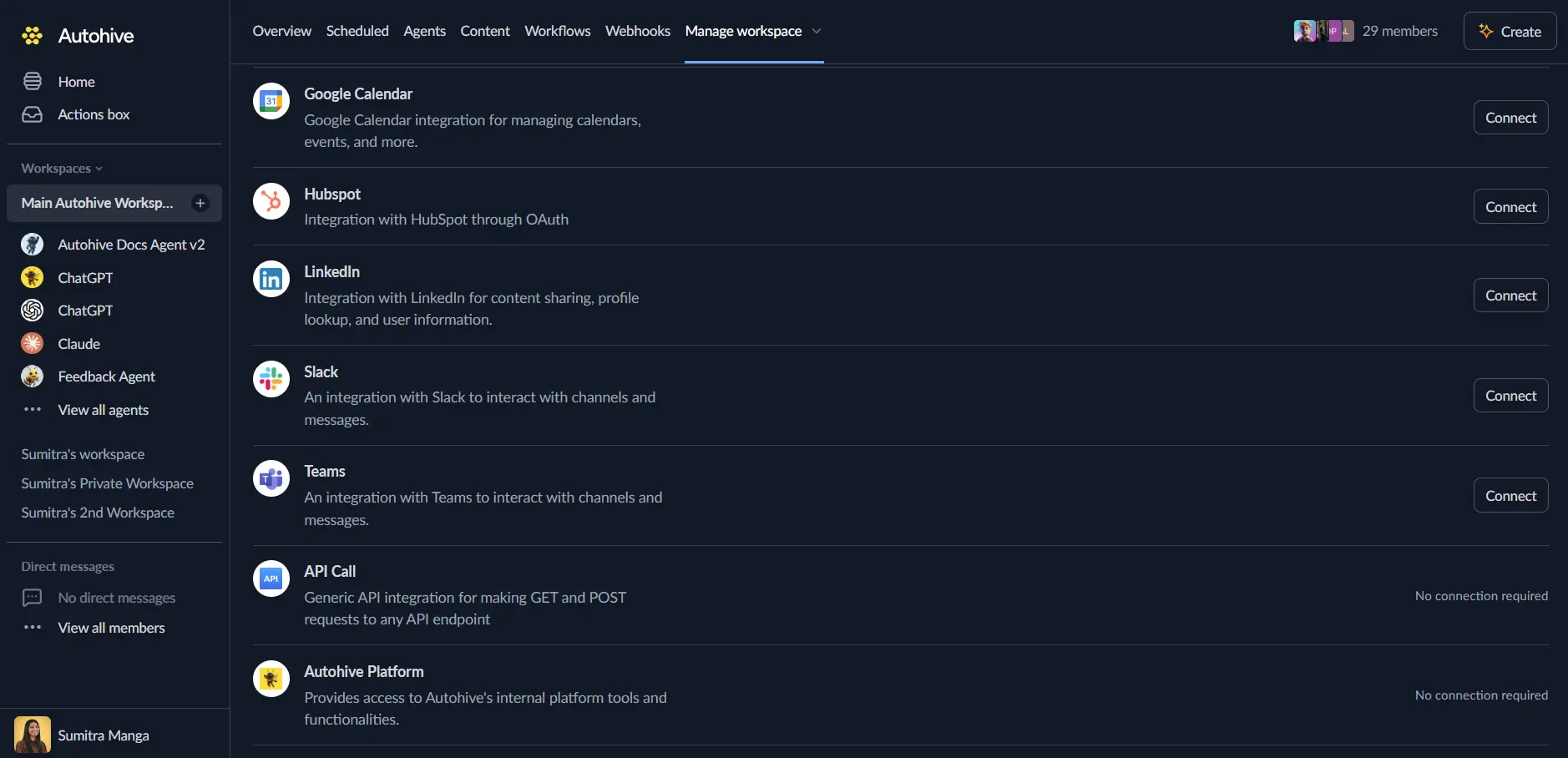Gmail
The Autohive Gmail integration connects your Gmail account with Autohive’s automation platform, enabling:
- Email management - Send, read, reply to emails with support for both plain text and rich HTML formatting
- Inbox organization - List emails with filtering by read status, labels, and inbox location
- Label management - Create custom labels, apply labels to emails, and organize your mailbox automatically
- Draft operations - Create, update, send, and manage email drafts for scheduled sending
- Thread handling - Reply to email threads, retrieve full thread conversations, and manage email chains
- Email status control - Mark emails as read/unread, archive emails, and manage email visibility
- Attachment support - Handle file attachments in both incoming and outgoing emails
- Advanced filtering - Search emails by labels, custom queries, and various Gmail search parameters
Install the integration
-
Log in to Autohive and navigate to Your user profile > Connections or Your workspace -> Manage workspace
-
Locate the Gmail Integration card and click Connect

-
Select your Google account and click Choose Account
-
Review and approve permissions. Autohive requests access to:
Ensure you approve the permissions required in order for the integration to function as expected.
-
Confirm installation - you’ll be redirected to Autohive with “Connected” status displayed
Use the integration
You can now use the integration with your agents, workflows and scheduled tasks!
- Follow our Create your first agent guide on how to create an agent.
- In the ‘Agent settings’, scroll down to the ‘Add capabilities’ section and turn on the Gmail capability. You can choose what individual Gmail capabilities to turn on and off.
- Once the settings have been selected, begin prompting the agent of the workflow you’d like to achieve with Autohive and Gmail!
Available capabilities
Email Composition and Sending
- Send Email: Compose and send new emails with recipients (To, CC, BCC), subject, body content, and optional file attachments
- Reply to Thread: Reply to specific email threads with thread ID, message ID, and automatic recipient handling
- HTML and Plain Text Support: Send emails with rich HTML formatting including tables, links, and styling with automatic plain text conversion
- File Attachments: Attach multiple files with automatic MIME type detection and base64 encoding
Draft Management
- Create Draft: Create email drafts with recipients, subject, body, and attachments for later sending
- Update Draft: Modify existing drafts by draft ID including content, recipients, and file attachments
- List Drafts: Retrieve all drafts with pagination, filtering by query parameters, and draft metadata
- Get Draft: Get specific draft details by draft ID including full message content and recipients
- Send Draft: Convert and send existing drafts by draft ID to specified recipients
- Delete Draft: Permanently remove drafts by draft ID from your mailbox
Inbox and Email Retrieval
- List Unread Emails: Retrieve unread emails with pagination (maxResults parameter) and optional includeSpamTrash filtering
- Read Inbox: Access inbox messages with query-based filtering, pagination, and complete message metadata
- Read Email: Get full email content by message ID including HTML/plain text body, headers, and attachment details
- Get Thread Emails: Retrieve all messages in a thread by thread ID with full message content and chronological ordering
Label and Organization Management
- List Labels: Get all Gmail labels including system labels (INBOX, SENT, DRAFT) and custom user-created labels
- Create Label: Create new custom labels with specified names for email categorization
- List Emails by Label: Search emails by specific label IDs with pagination and filtering options
- Add Labels to Emails: Apply one or more labels to specific emails using message IDs and label IDs
- Remove Labels from Emails: Remove specified labels from emails using message IDs and label IDs
Email Status Management
- Mark Emails as Read: Remove UNREAD label from specified emails using message IDs
- Mark Emails as Unread: Add UNREAD label to specified emails using message IDs
- Archive Emails: Remove INBOX label from emails using message IDs while preserving accessibility
- Gmail Label System: Manage email organization through Gmail’s label-based system
User and Account Information
- Get User Info: Retrieve authenticated user’s profile information including email address, message counts, and thread counts
- Account Statistics: Access mailbox metrics including total messages, threads, and Gmail-specific account data
Key features
Advanced Email Search
- Search emails using Gmail’s powerful query syntax
- Filter by sender, subject, date ranges, and content
- Combine multiple search criteria for precise results
- Support for boolean operators and advanced Gmail search features
Pagination Support
- Handle large mailboxes with efficient pagination
- Navigate through email lists without performance issues
- Support for both forward and backward pagination
- Configurable page sizes for optimal performance
HTML Email Support
- Send rich HTML emails with professional formatting
- Automatic plain text fallback for compatibility
- Support for inline styling and responsive design
- Table formatting for structured content presentation
Label and Filter Management
- Create and manage custom Gmail labels
- Apply multiple labels to emails for advanced organization
- Filter emails by single or multiple label combinations
- Support for both user-created and system Gmail labels
Disconnect the integration
Important: Disconnecting stops data synchronization but preserves existing data in both systems.
- Navigate to Your user profile -> Connections or Your workspace -> Manage workspace
- Find the Gmail Integration
- Click Disconnect and confirm
Data Impact: Existing data remains unchanged in both systems, but sync stops and Autohive loses Gmail API access.
Uninstall the app
From Google: Go to your Google Account settings > Security > Third-party apps with account access > Find Autohive and revoke access